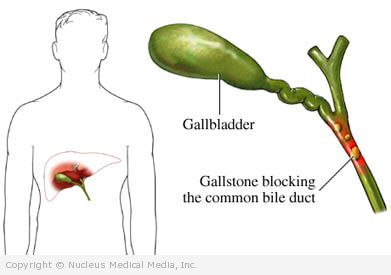(Biliary Colic; Calculus of Gallbladder; Cholangitis; Cholelithiasis; Cholecystitis; Cholecystolithiasis; Choledocholithiasis)
Gallstones – Definition
Gallstones are pieces of stone-like material that form in the gallbladder. The gallbladder is located near the liver and stomach. The majority of gallstones are made up of cholesterol. The rest are made up of bilirubin. Bilirubin is a breakdown pigment of the blood product hemoglobin.
Biliary colic is the pain caused by a gallstone stuck in the bile duct, a tube that carries bile to the small intestine. Sometimes, a stone caught in the bile duct causes cholecystitis (inflammation of the gallbladder). Cholangitis is inflammation of the bile duct caused by a gallstone or a bacterial infection.
Gallstones – Causes
The gallbladder stores bile. This fluid is produced in the liver and used in the small intestine to digest fat. Bile contains cholesterol, water, bilirubin, and bile salts.
Gallstones can form under the following conditions:
- Too much absorption of bile salts from the bile
- Too much absorption of water from the bile
- Too much cholesterol in the bile
- Inflammation of the lining of the gallbladder
Gallstones – Risk Factors
These factors increase your chance of developing gallstones. Tell your doctor if you have any of these risk factors:
- Age: older than 60 years old
- Sex:
- Women between 20-60 years old and
- Women with high estrogen levels due to pregnancy, oral contraceptive use, or hormone replacement therapy
- Obesity
- Race: Pima Indians and other Native Americans, Mexican Americans, and Northern Europeans
- Use of cholesterol-lowering drugs
- Diabetes
- Rapid weight loss and fasting
- Previous gallstones
- Diseases of the gallbladder and ducts
- Blood diseases, including sickle cell anemia
Gallstones – Symptoms
Many people have gallstones without symptoms, called “silent gallstones.” In some cases, these are treated.
Gallstones may cause pain in the upper abdomen. This is sometimes called an attack because it begins suddenly, often after a fatty meal. The pain is severe and may last for 30 minutes or several hours.
Other symptoms include:
- Intermittent pain on the right, below the ribcage
- Bloating, nausea, and vomiting
- Belching, gas, and indigestion
If you have the following symptoms, see your doctor right away:
- Abdominal pain
- Sweating
- Chills
- Low-grade fever
- Jaundice (yellowish color of the skin or whites of the eyes)
- Clay-colored stools
Gallstones – Diagnosis
The doctor will ask about your symptoms and medical history, and perform a physical exam.
Tests may include:
- Abdominal x-ray — a test that uses radiation to take a picture of structures inside the body, about 15% of gallstones can be seen on plain x-rays.
- Ultrasound — a test that uses sound waves to find gallstones
- Magnetic resonance cholangiopancreatography (MRCP) — an accurate and non-invasive means of evaluating the pancreas and gallbladder
- Endoscopic retrograde cholangiopancreatography (ERCP) — a test that uses a combination of endoscopy (the use of a flexible fiberoptic camera to look into your digestive system) and x-rays
- Cholecystogram or cholescintigraphy — x-rays that show movement of the gallbladder and any blockage of the cystic duct that carries bile to the bile duct
- Blood tests — may be used to find an infection, jaundice, pancreatitis, or an obstruction
Gallstones – Treatment
Talk to your doctor about the best treatment plan for you. Options include:
Surgical Treatments
- Laparoscopic cholecystectomy — Laparoscopic cholecystectomy is the removal of the gallbladder through several small incisions in the abdomen. To view the gallbladder, a small, lighted tube with a camera is inserted into one of the incisions. Surgical instruments are used to remove the gallbladder through one of the other incisions.
- Open cholecystectomy — Open cholecystectomy is the removal of the gallbladder through a large incision in the abdomen. This is necessary if there is an infection in the abdomen or a great deal of scar tissue.
Medications
Your doctor may give you medicine to dissolve small stones. You may need to take medicine for months or even years.
Other Treatments
Another procedure that may be used to treat gallstones is called endoscopic retrograde cholangiopancreatography (ERCP). ERCP uses a combination of endoscopy and x-rays to locate and remove gallstones before or during gallbladder surgery.
Gallstones – Prevention
To reduce your chance of getting gallstones:
- Maintain a healthy weight.
- Avoid rapid weight loss diets.
- Exercise regularly.
- Eat a diet low in saturated fat.
- Eat plenty of fruits, vegetables, and whole grain foods.

